Analysis of Organizational Learning and Change at Sanitarium: A Report
VerifiedAdded on 2023/05/29
|9
|2243
|65
Report
AI Summary
This report provides an in-depth analysis of Sanitarium Health and Wellbeing's organizational culture, change management strategies, and employee engagement practices. It examines Sanitarium's values, mission, and vision, highlighting how they have adapted to changes in the food industry and consumer preferences. The report details the company's initiatives, such as the use of OCI and OEI surveys, the implementation of the iGro system for employee-manager communication, and various training programs. It further explores Sanitarium's recognition as an employer of choice and its strategies for employee retention, including competitive benefits and a focus on employee development. The report also offers recommendations for future improvements, such as expanding into global markets and addressing potential management and competition challenges. The analysis emphasizes Sanitarium's commitment to employee well-being and its success in fostering a strong organizational culture that contributes to high employee engagement and low turnover rates.
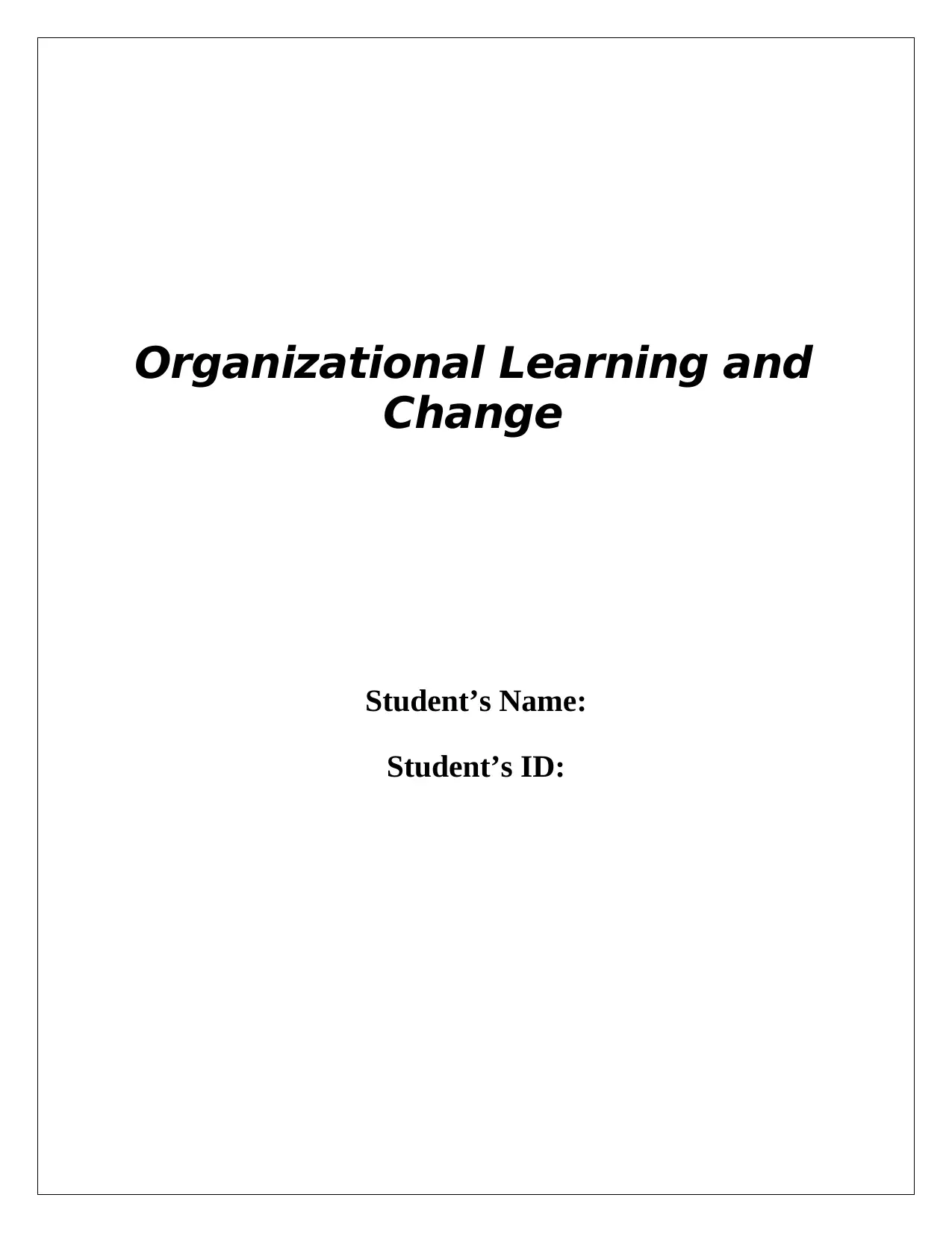
Organizational Learning and
Change
Student’s Name:
Student’s ID:
Change
Student’s Name:
Student’s ID:
Paraphrase This Document
Need a fresh take? Get an instant paraphrase of this document with our AI Paraphraser
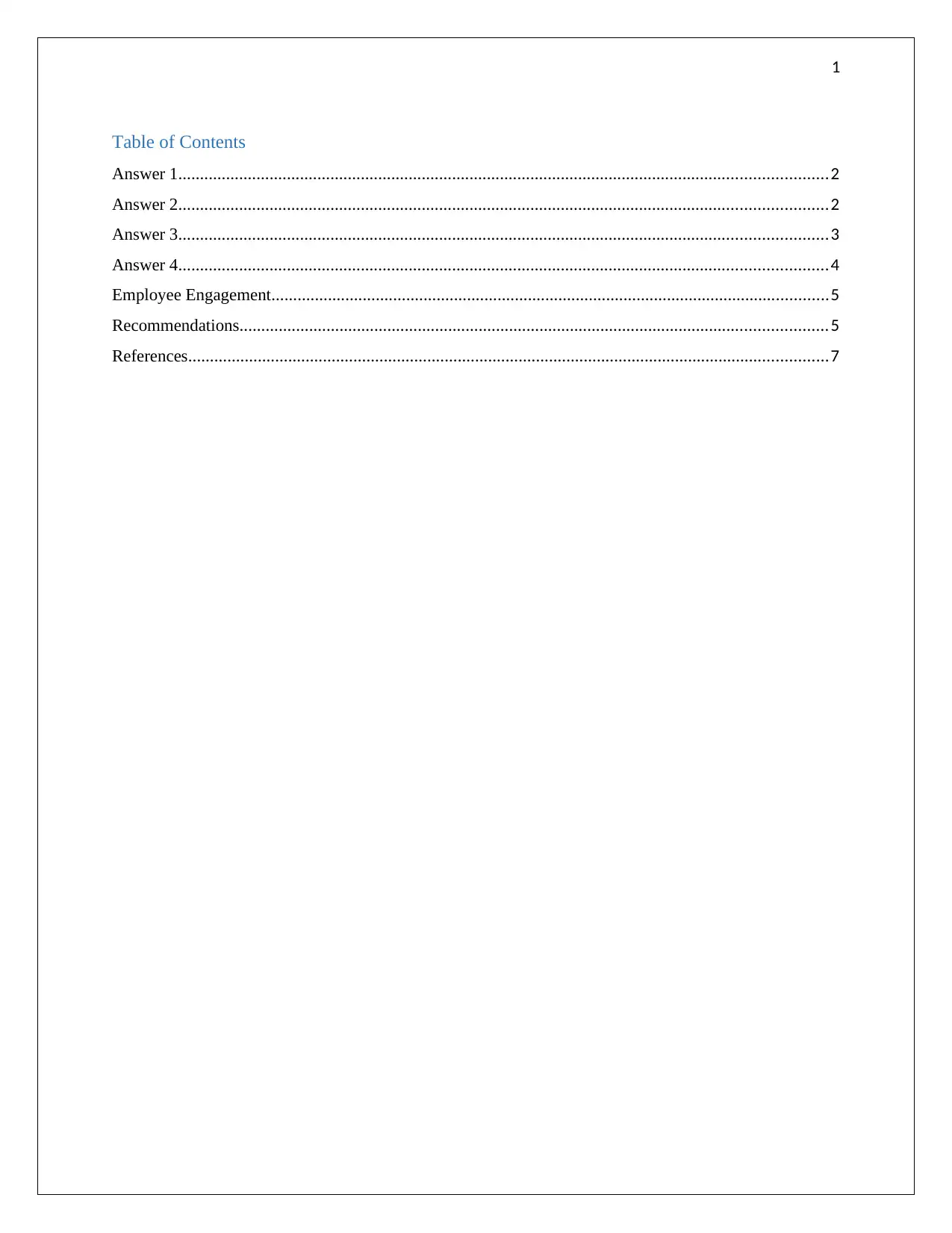
1
Table of Contents
Answer 1.....................................................................................................................................................2
Answer 2.....................................................................................................................................................2
Answer 3.....................................................................................................................................................3
Answer 4.....................................................................................................................................................4
Employee Engagement................................................................................................................................5
Recommendations.......................................................................................................................................5
References...................................................................................................................................................7
Table of Contents
Answer 1.....................................................................................................................................................2
Answer 2.....................................................................................................................................................2
Answer 3.....................................................................................................................................................3
Answer 4.....................................................................................................................................................4
Employee Engagement................................................................................................................................5
Recommendations.......................................................................................................................................5
References...................................................................................................................................................7
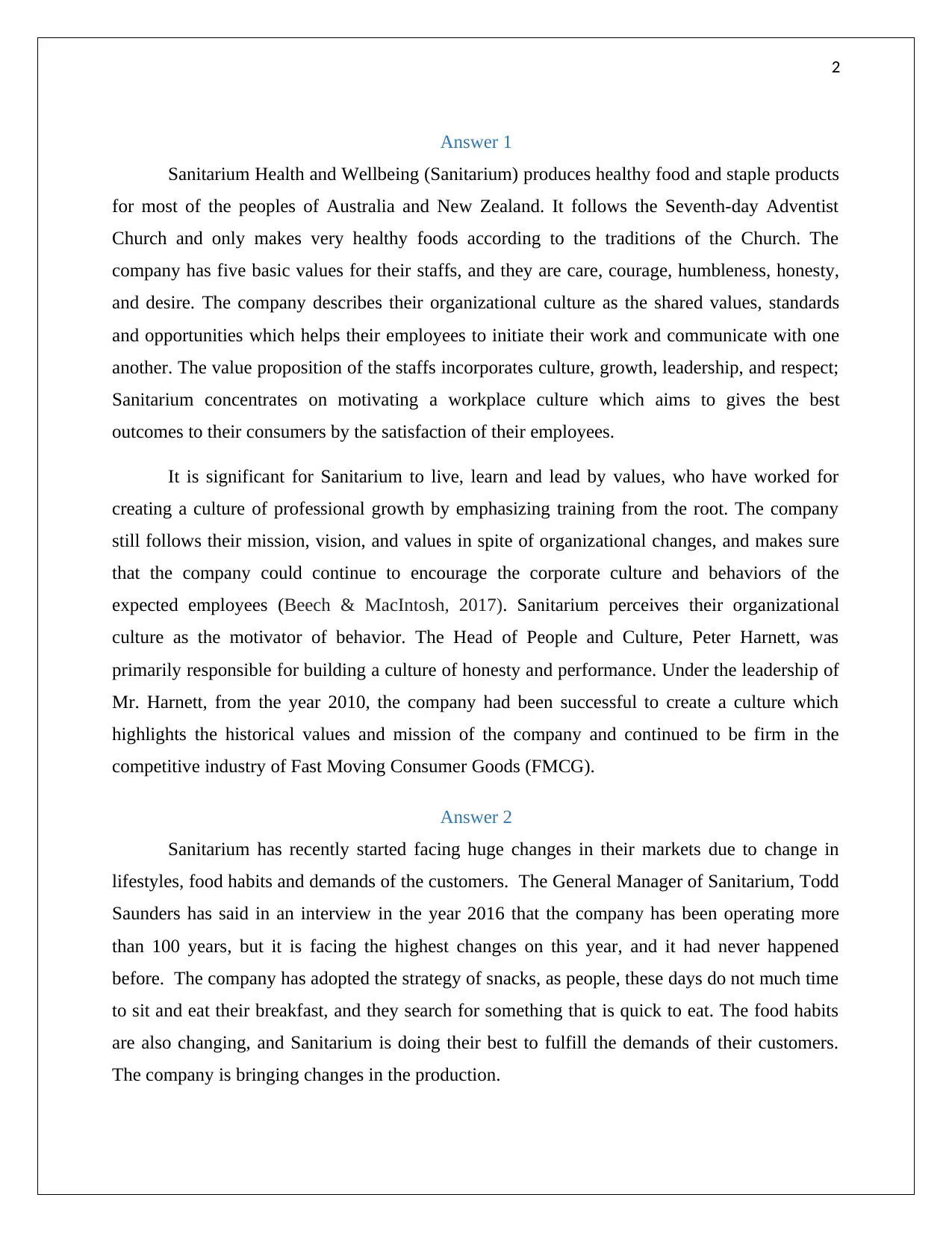
2
Answer 1
Sanitarium Health and Wellbeing (Sanitarium) produces healthy food and staple products
for most of the peoples of Australia and New Zealand. It follows the Seventh-day Adventist
Church and only makes very healthy foods according to the traditions of the Church. The
company has five basic values for their staffs, and they are care, courage, humbleness, honesty,
and desire. The company describes their organizational culture as the shared values, standards
and opportunities which helps their employees to initiate their work and communicate with one
another. The value proposition of the staffs incorporates culture, growth, leadership, and respect;
Sanitarium concentrates on motivating a workplace culture which aims to gives the best
outcomes to their consumers by the satisfaction of their employees.
It is significant for Sanitarium to live, learn and lead by values, who have worked for
creating a culture of professional growth by emphasizing training from the root. The company
still follows their mission, vision, and values in spite of organizational changes, and makes sure
that the company could continue to encourage the corporate culture and behaviors of the
expected employees (Beech & MacIntosh, 2017). Sanitarium perceives their organizational
culture as the motivator of behavior. The Head of People and Culture, Peter Harnett, was
primarily responsible for building a culture of honesty and performance. Under the leadership of
Mr. Harnett, from the year 2010, the company had been successful to create a culture which
highlights the historical values and mission of the company and continued to be firm in the
competitive industry of Fast Moving Consumer Goods (FMCG).
Answer 2
Sanitarium has recently started facing huge changes in their markets due to change in
lifestyles, food habits and demands of the customers. The General Manager of Sanitarium, Todd
Saunders has said in an interview in the year 2016 that the company has been operating more
than 100 years, but it is facing the highest changes on this year, and it had never happened
before. The company has adopted the strategy of snacks, as people, these days do not much time
to sit and eat their breakfast, and they search for something that is quick to eat. The food habits
are also changing, and Sanitarium is doing their best to fulfill the demands of their customers.
The company is bringing changes in the production.
Answer 1
Sanitarium Health and Wellbeing (Sanitarium) produces healthy food and staple products
for most of the peoples of Australia and New Zealand. It follows the Seventh-day Adventist
Church and only makes very healthy foods according to the traditions of the Church. The
company has five basic values for their staffs, and they are care, courage, humbleness, honesty,
and desire. The company describes their organizational culture as the shared values, standards
and opportunities which helps their employees to initiate their work and communicate with one
another. The value proposition of the staffs incorporates culture, growth, leadership, and respect;
Sanitarium concentrates on motivating a workplace culture which aims to gives the best
outcomes to their consumers by the satisfaction of their employees.
It is significant for Sanitarium to live, learn and lead by values, who have worked for
creating a culture of professional growth by emphasizing training from the root. The company
still follows their mission, vision, and values in spite of organizational changes, and makes sure
that the company could continue to encourage the corporate culture and behaviors of the
expected employees (Beech & MacIntosh, 2017). Sanitarium perceives their organizational
culture as the motivator of behavior. The Head of People and Culture, Peter Harnett, was
primarily responsible for building a culture of honesty and performance. Under the leadership of
Mr. Harnett, from the year 2010, the company had been successful to create a culture which
highlights the historical values and mission of the company and continued to be firm in the
competitive industry of Fast Moving Consumer Goods (FMCG).
Answer 2
Sanitarium has recently started facing huge changes in their markets due to change in
lifestyles, food habits and demands of the customers. The General Manager of Sanitarium, Todd
Saunders has said in an interview in the year 2016 that the company has been operating more
than 100 years, but it is facing the highest changes on this year, and it had never happened
before. The company has adopted the strategy of snacks, as people, these days do not much time
to sit and eat their breakfast, and they search for something that is quick to eat. The food habits
are also changing, and Sanitarium is doing their best to fulfill the demands of their customers.
The company is bringing changes in the production.
⊘ This is a preview!⊘
Do you want full access?
Subscribe today to unlock all pages.

Trusted by 1+ million students worldwide
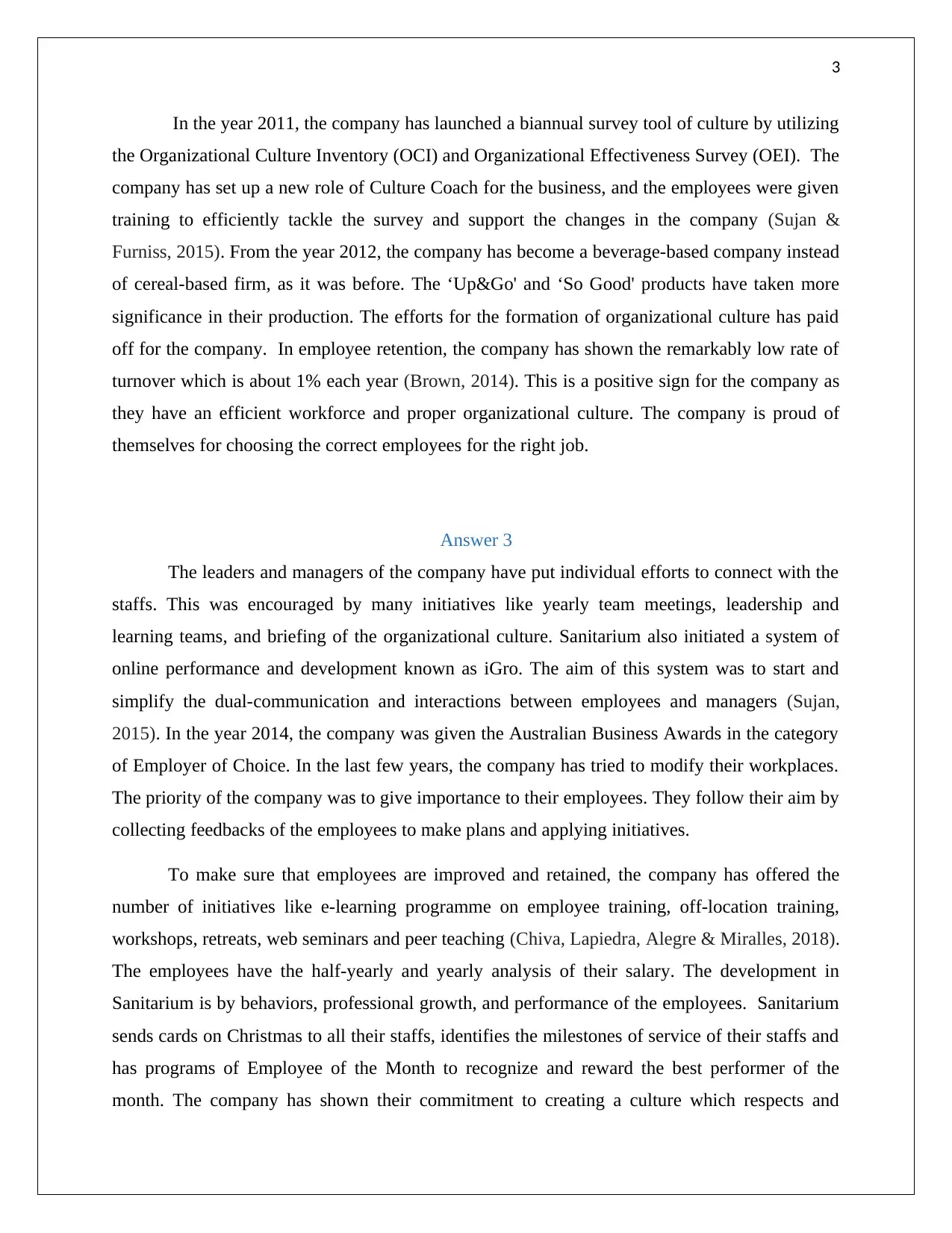
3
In the year 2011, the company has launched a biannual survey tool of culture by utilizing
the Organizational Culture Inventory (OCI) and Organizational Effectiveness Survey (OEI). The
company has set up a new role of Culture Coach for the business, and the employees were given
training to efficiently tackle the survey and support the changes in the company (Sujan &
Furniss, 2015). From the year 2012, the company has become a beverage-based company instead
of cereal-based firm, as it was before. The ‘Up&Go' and ‘So Good' products have taken more
significance in their production. The efforts for the formation of organizational culture has paid
off for the company. In employee retention, the company has shown the remarkably low rate of
turnover which is about 1% each year (Brown, 2014). This is a positive sign for the company as
they have an efficient workforce and proper organizational culture. The company is proud of
themselves for choosing the correct employees for the right job.
Answer 3
The leaders and managers of the company have put individual efforts to connect with the
staffs. This was encouraged by many initiatives like yearly team meetings, leadership and
learning teams, and briefing of the organizational culture. Sanitarium also initiated a system of
online performance and development known as iGro. The aim of this system was to start and
simplify the dual-communication and interactions between employees and managers (Sujan,
2015). In the year 2014, the company was given the Australian Business Awards in the category
of Employer of Choice. In the last few years, the company has tried to modify their workplaces.
The priority of the company was to give importance to their employees. They follow their aim by
collecting feedbacks of the employees to make plans and applying initiatives.
To make sure that employees are improved and retained, the company has offered the
number of initiatives like e-learning programme on employee training, off-location training,
workshops, retreats, web seminars and peer teaching (Chiva, Lapiedra, Alegre & Miralles, 2018).
The employees have the half-yearly and yearly analysis of their salary. The development in
Sanitarium is by behaviors, professional growth, and performance of the employees. Sanitarium
sends cards on Christmas to all their staffs, identifies the milestones of service of their staffs and
has programs of Employee of the Month to recognize and reward the best performer of the
month. The company has shown their commitment to creating a culture which respects and
In the year 2011, the company has launched a biannual survey tool of culture by utilizing
the Organizational Culture Inventory (OCI) and Organizational Effectiveness Survey (OEI). The
company has set up a new role of Culture Coach for the business, and the employees were given
training to efficiently tackle the survey and support the changes in the company (Sujan &
Furniss, 2015). From the year 2012, the company has become a beverage-based company instead
of cereal-based firm, as it was before. The ‘Up&Go' and ‘So Good' products have taken more
significance in their production. The efforts for the formation of organizational culture has paid
off for the company. In employee retention, the company has shown the remarkably low rate of
turnover which is about 1% each year (Brown, 2014). This is a positive sign for the company as
they have an efficient workforce and proper organizational culture. The company is proud of
themselves for choosing the correct employees for the right job.
Answer 3
The leaders and managers of the company have put individual efforts to connect with the
staffs. This was encouraged by many initiatives like yearly team meetings, leadership and
learning teams, and briefing of the organizational culture. Sanitarium also initiated a system of
online performance and development known as iGro. The aim of this system was to start and
simplify the dual-communication and interactions between employees and managers (Sujan,
2015). In the year 2014, the company was given the Australian Business Awards in the category
of Employer of Choice. In the last few years, the company has tried to modify their workplaces.
The priority of the company was to give importance to their employees. They follow their aim by
collecting feedbacks of the employees to make plans and applying initiatives.
To make sure that employees are improved and retained, the company has offered the
number of initiatives like e-learning programme on employee training, off-location training,
workshops, retreats, web seminars and peer teaching (Chiva, Lapiedra, Alegre & Miralles, 2018).
The employees have the half-yearly and yearly analysis of their salary. The development in
Sanitarium is by behaviors, professional growth, and performance of the employees. Sanitarium
sends cards on Christmas to all their staffs, identifies the milestones of service of their staffs and
has programs of Employee of the Month to recognize and reward the best performer of the
month. The company has shown their commitment to creating a culture which respects and
Paraphrase This Document
Need a fresh take? Get an instant paraphrase of this document with our AI Paraphraser
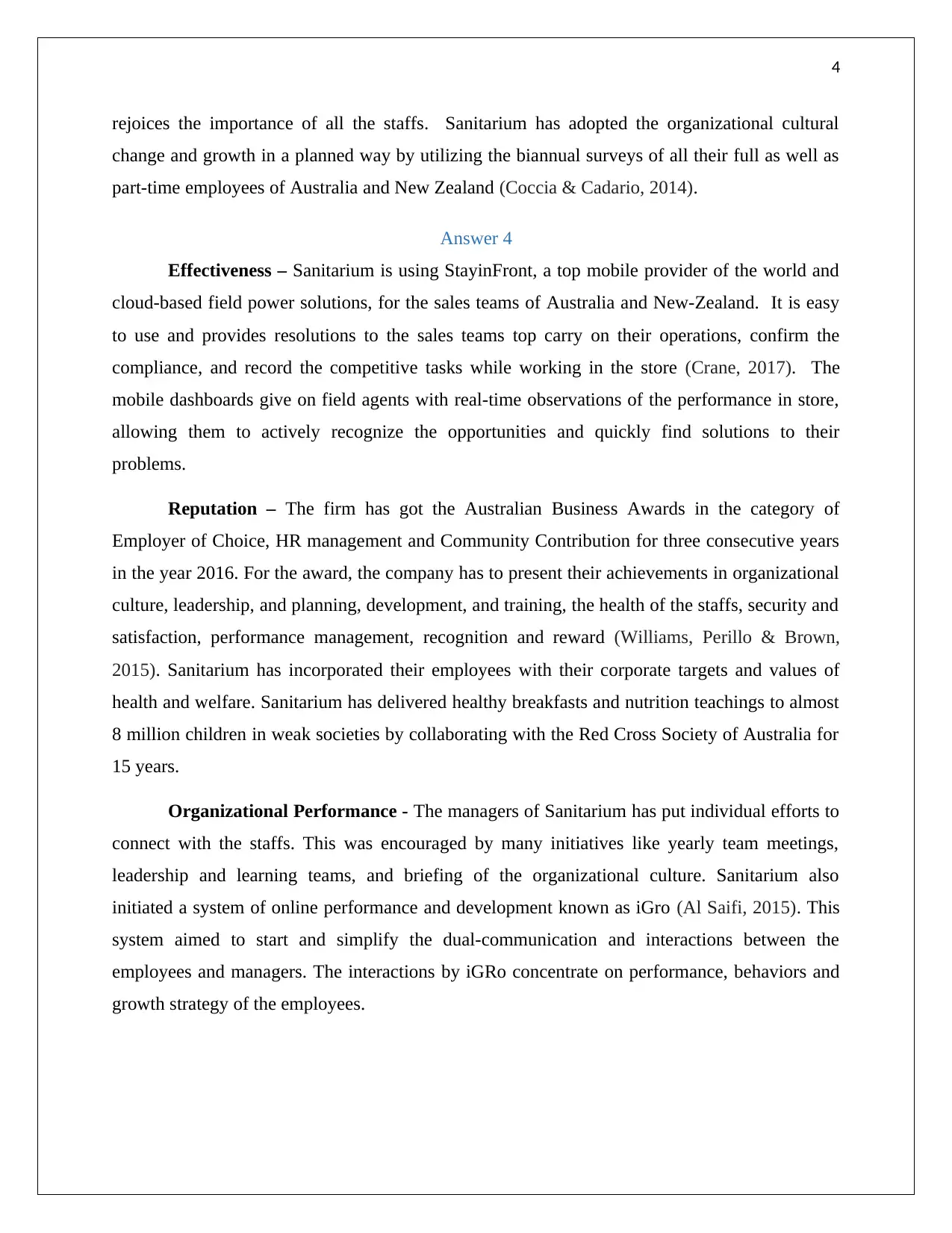
4
rejoices the importance of all the staffs. Sanitarium has adopted the organizational cultural
change and growth in a planned way by utilizing the biannual surveys of all their full as well as
part-time employees of Australia and New Zealand (Coccia & Cadario, 2014).
Answer 4
Effectiveness – Sanitarium is using StayinFront, a top mobile provider of the world and
cloud-based field power solutions, for the sales teams of Australia and New-Zealand. It is easy
to use and provides resolutions to the sales teams top carry on their operations, confirm the
compliance, and record the competitive tasks while working in the store (Crane, 2017). The
mobile dashboards give on field agents with real-time observations of the performance in store,
allowing them to actively recognize the opportunities and quickly find solutions to their
problems.
Reputation – The firm has got the Australian Business Awards in the category of
Employer of Choice, HR management and Community Contribution for three consecutive years
in the year 2016. For the award, the company has to present their achievements in organizational
culture, leadership, and planning, development, and training, the health of the staffs, security and
satisfaction, performance management, recognition and reward (Williams, Perillo & Brown,
2015). Sanitarium has incorporated their employees with their corporate targets and values of
health and welfare. Sanitarium has delivered healthy breakfasts and nutrition teachings to almost
8 million children in weak societies by collaborating with the Red Cross Society of Australia for
15 years.
Organizational Performance - The managers of Sanitarium has put individual efforts to
connect with the staffs. This was encouraged by many initiatives like yearly team meetings,
leadership and learning teams, and briefing of the organizational culture. Sanitarium also
initiated a system of online performance and development known as iGro (Al Saifi, 2015). This
system aimed to start and simplify the dual-communication and interactions between the
employees and managers. The interactions by iGRo concentrate on performance, behaviors and
growth strategy of the employees.
rejoices the importance of all the staffs. Sanitarium has adopted the organizational cultural
change and growth in a planned way by utilizing the biannual surveys of all their full as well as
part-time employees of Australia and New Zealand (Coccia & Cadario, 2014).
Answer 4
Effectiveness – Sanitarium is using StayinFront, a top mobile provider of the world and
cloud-based field power solutions, for the sales teams of Australia and New-Zealand. It is easy
to use and provides resolutions to the sales teams top carry on their operations, confirm the
compliance, and record the competitive tasks while working in the store (Crane, 2017). The
mobile dashboards give on field agents with real-time observations of the performance in store,
allowing them to actively recognize the opportunities and quickly find solutions to their
problems.
Reputation – The firm has got the Australian Business Awards in the category of
Employer of Choice, HR management and Community Contribution for three consecutive years
in the year 2016. For the award, the company has to present their achievements in organizational
culture, leadership, and planning, development, and training, the health of the staffs, security and
satisfaction, performance management, recognition and reward (Williams, Perillo & Brown,
2015). Sanitarium has incorporated their employees with their corporate targets and values of
health and welfare. Sanitarium has delivered healthy breakfasts and nutrition teachings to almost
8 million children in weak societies by collaborating with the Red Cross Society of Australia for
15 years.
Organizational Performance - The managers of Sanitarium has put individual efforts to
connect with the staffs. This was encouraged by many initiatives like yearly team meetings,
leadership and learning teams, and briefing of the organizational culture. Sanitarium also
initiated a system of online performance and development known as iGro (Al Saifi, 2015). This
system aimed to start and simplify the dual-communication and interactions between the
employees and managers. The interactions by iGRo concentrate on performance, behaviors and
growth strategy of the employees.
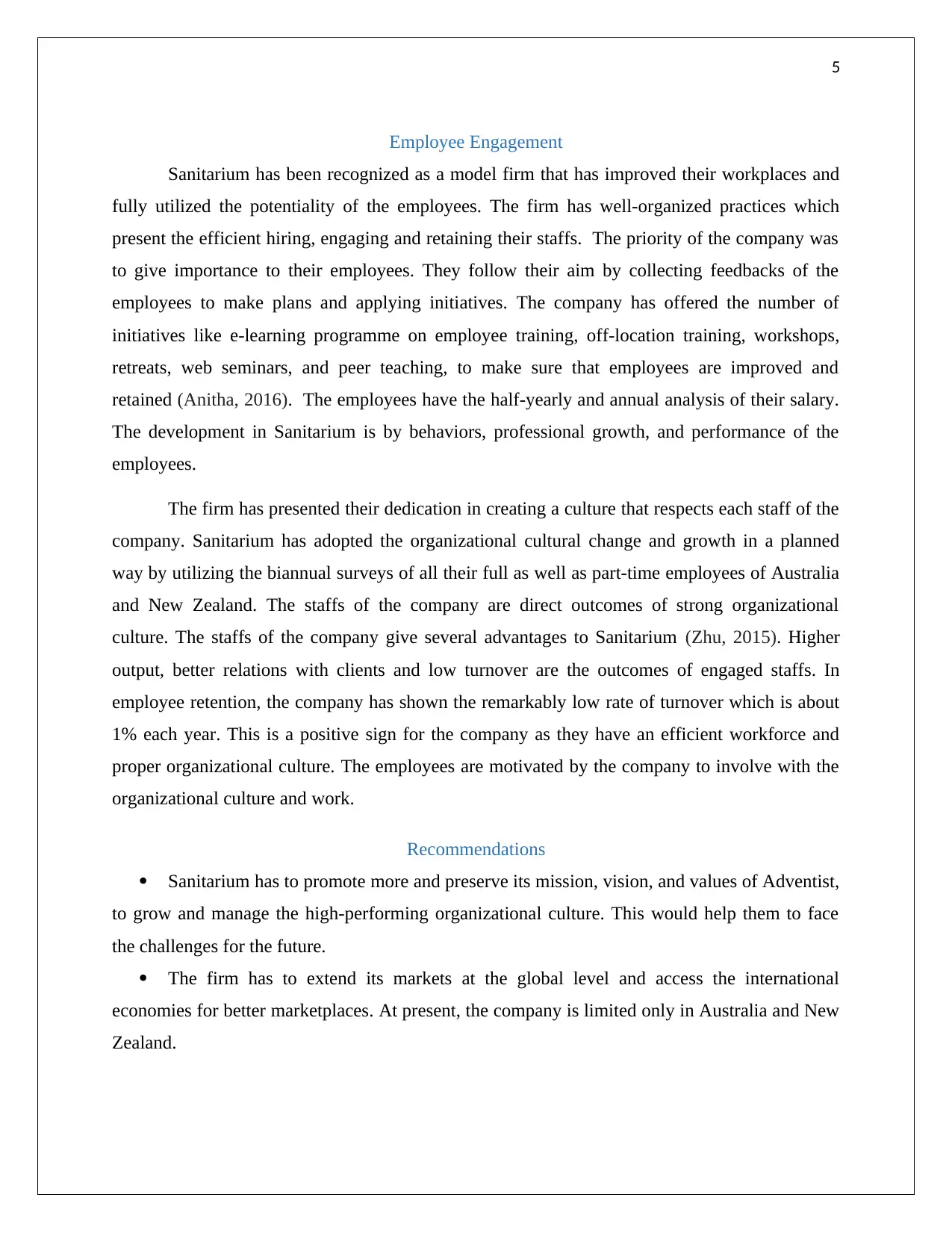
5
Employee Engagement
Sanitarium has been recognized as a model firm that has improved their workplaces and
fully utilized the potentiality of the employees. The firm has well-organized practices which
present the efficient hiring, engaging and retaining their staffs. The priority of the company was
to give importance to their employees. They follow their aim by collecting feedbacks of the
employees to make plans and applying initiatives. The company has offered the number of
initiatives like e-learning programme on employee training, off-location training, workshops,
retreats, web seminars, and peer teaching, to make sure that employees are improved and
retained (Anitha, 2016). The employees have the half-yearly and annual analysis of their salary.
The development in Sanitarium is by behaviors, professional growth, and performance of the
employees.
The firm has presented their dedication in creating a culture that respects each staff of the
company. Sanitarium has adopted the organizational cultural change and growth in a planned
way by utilizing the biannual surveys of all their full as well as part-time employees of Australia
and New Zealand. The staffs of the company are direct outcomes of strong organizational
culture. The staffs of the company give several advantages to Sanitarium (Zhu, 2015). Higher
output, better relations with clients and low turnover are the outcomes of engaged staffs. In
employee retention, the company has shown the remarkably low rate of turnover which is about
1% each year. This is a positive sign for the company as they have an efficient workforce and
proper organizational culture. The employees are motivated by the company to involve with the
organizational culture and work.
Recommendations
Sanitarium has to promote more and preserve its mission, vision, and values of Adventist,
to grow and manage the high-performing organizational culture. This would help them to face
the challenges for the future.
The firm has to extend its markets at the global level and access the international
economies for better marketplaces. At present, the company is limited only in Australia and New
Zealand.
Employee Engagement
Sanitarium has been recognized as a model firm that has improved their workplaces and
fully utilized the potentiality of the employees. The firm has well-organized practices which
present the efficient hiring, engaging and retaining their staffs. The priority of the company was
to give importance to their employees. They follow their aim by collecting feedbacks of the
employees to make plans and applying initiatives. The company has offered the number of
initiatives like e-learning programme on employee training, off-location training, workshops,
retreats, web seminars, and peer teaching, to make sure that employees are improved and
retained (Anitha, 2016). The employees have the half-yearly and annual analysis of their salary.
The development in Sanitarium is by behaviors, professional growth, and performance of the
employees.
The firm has presented their dedication in creating a culture that respects each staff of the
company. Sanitarium has adopted the organizational cultural change and growth in a planned
way by utilizing the biannual surveys of all their full as well as part-time employees of Australia
and New Zealand. The staffs of the company are direct outcomes of strong organizational
culture. The staffs of the company give several advantages to Sanitarium (Zhu, 2015). Higher
output, better relations with clients and low turnover are the outcomes of engaged staffs. In
employee retention, the company has shown the remarkably low rate of turnover which is about
1% each year. This is a positive sign for the company as they have an efficient workforce and
proper organizational culture. The employees are motivated by the company to involve with the
organizational culture and work.
Recommendations
Sanitarium has to promote more and preserve its mission, vision, and values of Adventist,
to grow and manage the high-performing organizational culture. This would help them to face
the challenges for the future.
The firm has to extend its markets at the global level and access the international
economies for better marketplaces. At present, the company is limited only in Australia and New
Zealand.
⊘ This is a preview!⊘
Do you want full access?
Subscribe today to unlock all pages.

Trusted by 1+ million students worldwide
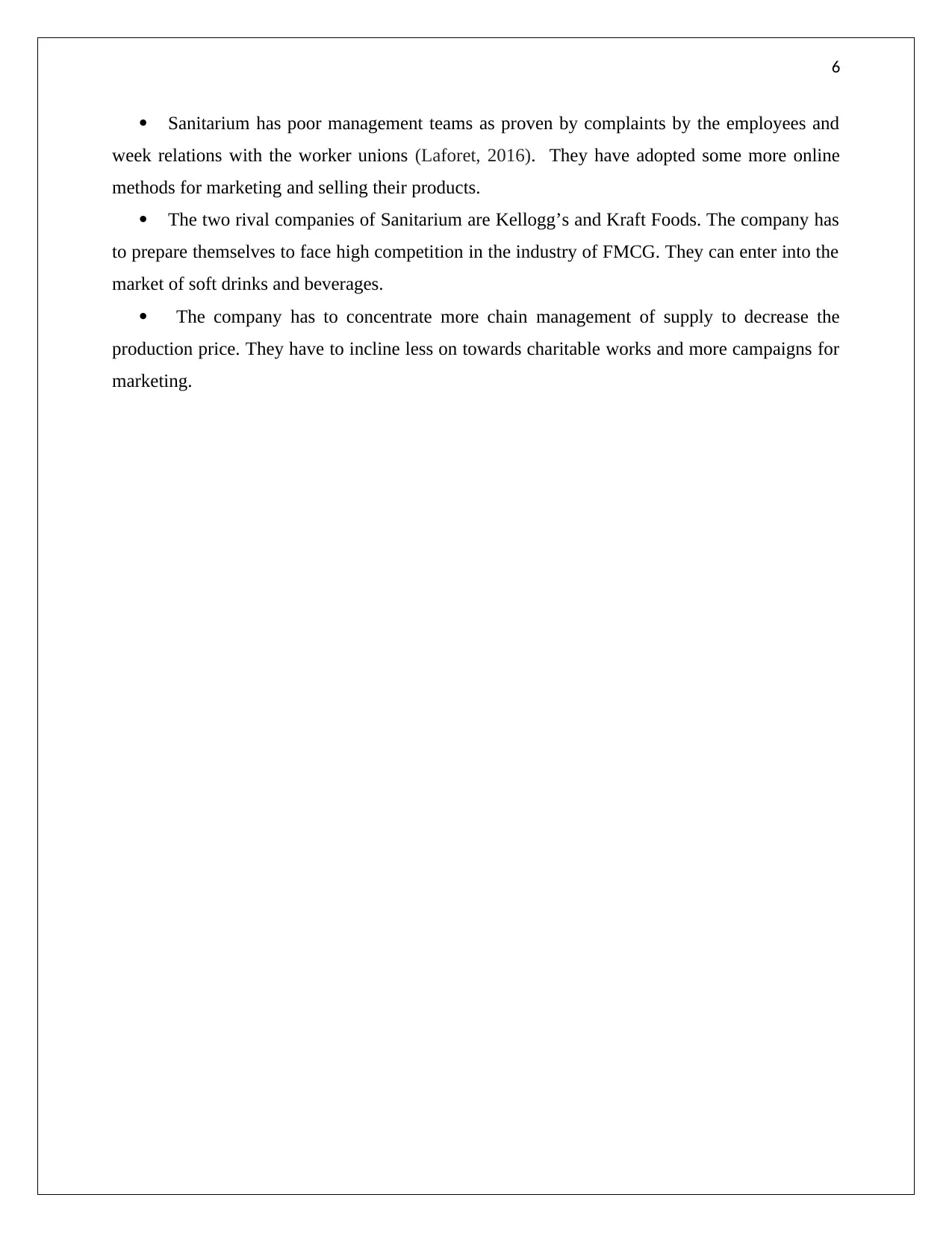
6
Sanitarium has poor management teams as proven by complaints by the employees and
week relations with the worker unions (Laforet, 2016). They have adopted some more online
methods for marketing and selling their products.
The two rival companies of Sanitarium are Kellogg’s and Kraft Foods. The company has
to prepare themselves to face high competition in the industry of FMCG. They can enter into the
market of soft drinks and beverages.
The company has to concentrate more chain management of supply to decrease the
production price. They have to incline less on towards charitable works and more campaigns for
marketing.
Sanitarium has poor management teams as proven by complaints by the employees and
week relations with the worker unions (Laforet, 2016). They have adopted some more online
methods for marketing and selling their products.
The two rival companies of Sanitarium are Kellogg’s and Kraft Foods. The company has
to prepare themselves to face high competition in the industry of FMCG. They can enter into the
market of soft drinks and beverages.
The company has to concentrate more chain management of supply to decrease the
production price. They have to incline less on towards charitable works and more campaigns for
marketing.
Paraphrase This Document
Need a fresh take? Get an instant paraphrase of this document with our AI Paraphraser
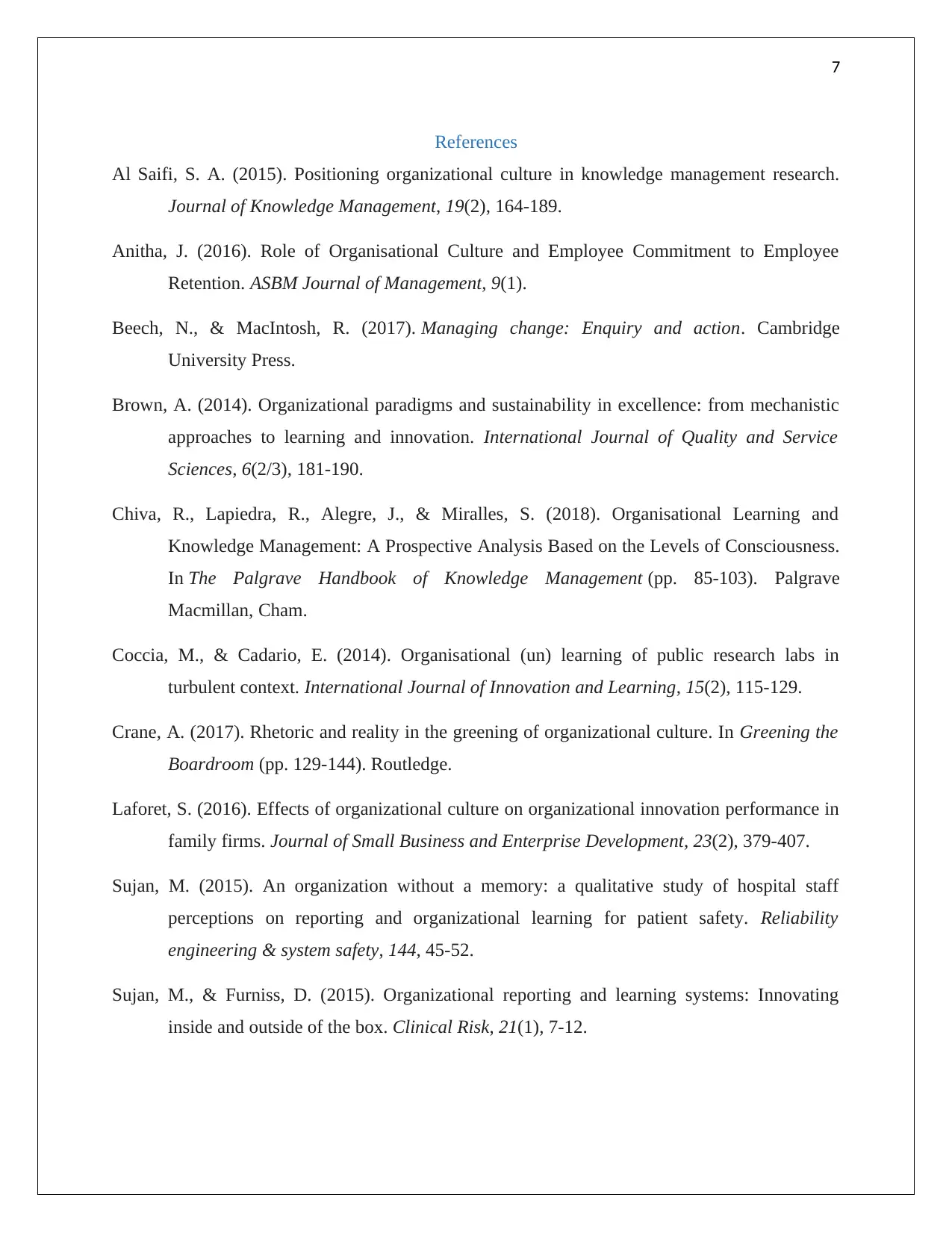
7
References
Al Saifi, S. A. (2015). Positioning organizational culture in knowledge management research.
Journal of Knowledge Management, 19(2), 164-189.
Anitha, J. (2016). Role of Organisational Culture and Employee Commitment to Employee
Retention. ASBM Journal of Management, 9(1).
Beech, N., & MacIntosh, R. (2017). Managing change: Enquiry and action. Cambridge
University Press.
Brown, A. (2014). Organizational paradigms and sustainability in excellence: from mechanistic
approaches to learning and innovation. International Journal of Quality and Service
Sciences, 6(2/3), 181-190.
Chiva, R., Lapiedra, R., Alegre, J., & Miralles, S. (2018). Organisational Learning and
Knowledge Management: A Prospective Analysis Based on the Levels of Consciousness.
In The Palgrave Handbook of Knowledge Management (pp. 85-103). Palgrave
Macmillan, Cham.
Coccia, M., & Cadario, E. (2014). Organisational (un) learning of public research labs in
turbulent context. International Journal of Innovation and Learning, 15(2), 115-129.
Crane, A. (2017). Rhetoric and reality in the greening of organizational culture. In Greening the
Boardroom (pp. 129-144). Routledge.
Laforet, S. (2016). Effects of organizational culture on organizational innovation performance in
family firms. Journal of Small Business and Enterprise Development, 23(2), 379-407.
Sujan, M. (2015). An organization without a memory: a qualitative study of hospital staff
perceptions on reporting and organizational learning for patient safety. Reliability
engineering & system safety, 144, 45-52.
Sujan, M., & Furniss, D. (2015). Organizational reporting and learning systems: Innovating
inside and outside of the box. Clinical Risk, 21(1), 7-12.
References
Al Saifi, S. A. (2015). Positioning organizational culture in knowledge management research.
Journal of Knowledge Management, 19(2), 164-189.
Anitha, J. (2016). Role of Organisational Culture and Employee Commitment to Employee
Retention. ASBM Journal of Management, 9(1).
Beech, N., & MacIntosh, R. (2017). Managing change: Enquiry and action. Cambridge
University Press.
Brown, A. (2014). Organizational paradigms and sustainability in excellence: from mechanistic
approaches to learning and innovation. International Journal of Quality and Service
Sciences, 6(2/3), 181-190.
Chiva, R., Lapiedra, R., Alegre, J., & Miralles, S. (2018). Organisational Learning and
Knowledge Management: A Prospective Analysis Based on the Levels of Consciousness.
In The Palgrave Handbook of Knowledge Management (pp. 85-103). Palgrave
Macmillan, Cham.
Coccia, M., & Cadario, E. (2014). Organisational (un) learning of public research labs in
turbulent context. International Journal of Innovation and Learning, 15(2), 115-129.
Crane, A. (2017). Rhetoric and reality in the greening of organizational culture. In Greening the
Boardroom (pp. 129-144). Routledge.
Laforet, S. (2016). Effects of organizational culture on organizational innovation performance in
family firms. Journal of Small Business and Enterprise Development, 23(2), 379-407.
Sujan, M. (2015). An organization without a memory: a qualitative study of hospital staff
perceptions on reporting and organizational learning for patient safety. Reliability
engineering & system safety, 144, 45-52.
Sujan, M., & Furniss, D. (2015). Organizational reporting and learning systems: Innovating
inside and outside of the box. Clinical Risk, 21(1), 7-12.
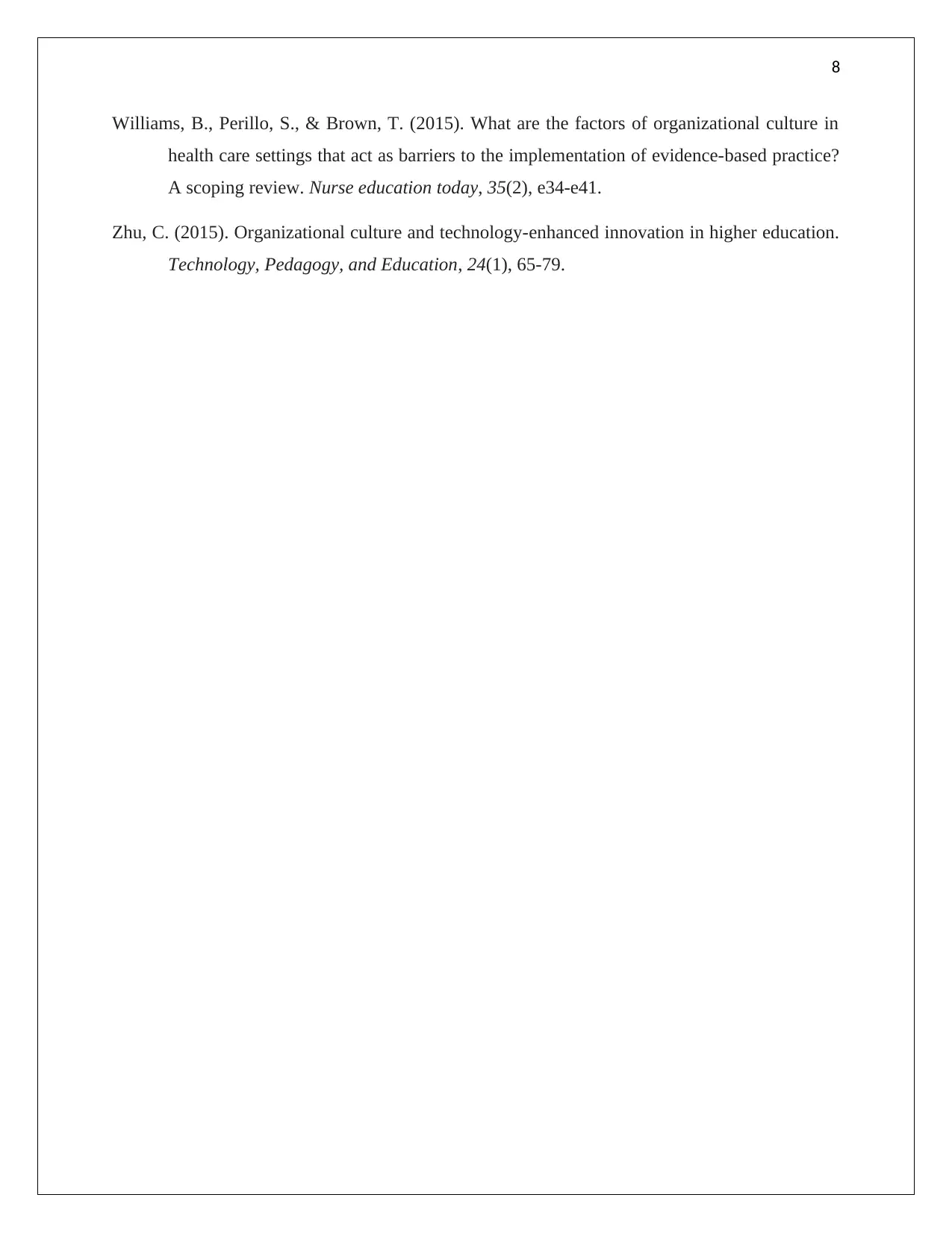
8
Williams, B., Perillo, S., & Brown, T. (2015). What are the factors of organizational culture in
health care settings that act as barriers to the implementation of evidence-based practice?
A scoping review. Nurse education today, 35(2), e34-e41.
Zhu, C. (2015). Organizational culture and technology-enhanced innovation in higher education.
Technology, Pedagogy, and Education, 24(1), 65-79.
Williams, B., Perillo, S., & Brown, T. (2015). What are the factors of organizational culture in
health care settings that act as barriers to the implementation of evidence-based practice?
A scoping review. Nurse education today, 35(2), e34-e41.
Zhu, C. (2015). Organizational culture and technology-enhanced innovation in higher education.
Technology, Pedagogy, and Education, 24(1), 65-79.
⊘ This is a preview!⊘
Do you want full access?
Subscribe today to unlock all pages.

Trusted by 1+ million students worldwide
1 out of 9
Related Documents
Your All-in-One AI-Powered Toolkit for Academic Success.
+13062052269
info@desklib.com
Available 24*7 on WhatsApp / Email
![[object Object]](/_next/static/media/star-bottom.7253800d.svg)
Unlock your academic potential
Copyright © 2020–2025 A2Z Services. All Rights Reserved. Developed and managed by ZUCOL.




